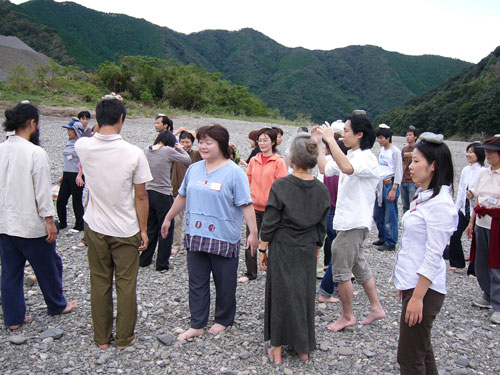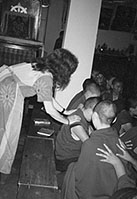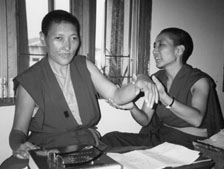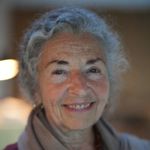by Judyth O. Weaver, Ph.D.
Note: This article was published in the SOMATICS JOURNAL, Fall/Winter 1997/8.
I lead Sensory Awareness workshops and classes in Japan, Taiwan, Canada, and also in Russia in the context of Rosen Method Trainings, in addition to the regular classes and workshops I offer in the U.S. My teacher, Charlotte Selver, with whom I have studied for 30 years and who has taught me so much, asks me what the differences are of leading the work in different cultures. My answer is basically, “none.”The culture that Sensory Awareness works with is the human culture; the specific country, language, or way of dressing is not the level where we meet. Our work goes underneath the vagaries of cultural experience and reaches down to the foundational essence of human nature. I am awed and thrilled about our basic humanity every time an experiment is met with honesty and human grace and a person, no matter what their homeland, is affected.This does not mean that there are not many cultural concerns and variations that need to be attended to. On the contrary, I want to be especially careful and not violate any cultural issues so that the students may feel safe and free to explore without worry that they be offended or need to protect themselves. I err on the side of safety, and consequently many experimenting situations that I would use in my familiar western context, I forego in other countries.
For instance, I know that touching any part of the head is considered very impolite for Chinese, so in Taiwan I don’t offer any experiments that might including touching a partner’s head. I am not so sure about that same taboo with the Japanese, but to be safe I also exclude that in Japan.
I know that there are many taboos about touching feet (in most Asian countries it is extremely disrespectful to have ones feet in the direction of a teacher or honored person or even show the soles of ones feet), so I don’t introduce any experiments that might bring us to put hands on feet or put feet on any part of a person.
I am also concerned about the propriety of touching other body parts, and also the issues of touching between men and women, so I don’t offer experiments that include touching of chests or diaphragms; I limit interpersonal contact to external areas, i.e. arms, shoulders, backs, etc.
I perceive the manner in which this work of Sensory Awareness is initially received is also different depending on culture.
I am part of a team of Rosen Method Practitioners who regularly teach in Russia. (Marion Rosen, the founder of this method traces her roots back to Elsa Gindler, Charlotte SelverÃs teacher, through her own first teacher in Germany, who was also a student of Gindler. And I find both ways of working very complementary.) Rosen training began there before the demise of the Soviet Union, a lengthy regime wherein it was best that people not feel much. In the classes, though, students are being asked to feel and pay attention, qualities that living in crowded situation with no sense of privacy or safety did not support, and these requests prompted vast changes in their consciousness. We are helping them find the time and space to “tune in” and pay attention to what is happening inside as well as out for perhaps the first time in their lives.
In 1993, when I first began teaching in Russia and introduced Sensory Awareness as an extension of their inner work and a basic fundamental to the Rosen work, I was moved by the tears and reports of discovery and relief by many of the students. It seems to me they were relieved that they could finally be sensitive to themselves at such depths after so many years of not being allowed to acknowledge what was happening to them. They continue to show their interest and gratitude for the help of deep sensing and ask to work further in this mode whenever I am there.
The wife of an ex-student of mine suggested I offer a half-day class in Tokyo last December, just to see if there was interest in her group of peers. Nineteen people showed up on a Thursday morning. I was told it was a “minor miracle” to have that many people leave their work to experience Sensory Awareness. By the end of the brief break we took mid-way in the short three-hour class I was surprised that they had already decided that this work was very important to them and had written information on the board that they would be meeting monthly to continue their exploration of Sensory Awareness. I offered them only such a small taste, and they gobbled it up and could understand that they wanted more.
On the other hand, my first experience in Taiwan was very different: The students who gathered for the first Sensory Awareness Workshops had already been introduced to the culture of “new age” workshops and had expectations of how they should act and what they would be receiving from the work. I was quite surprised at their cathartic and (what I considered) excessive responses to the simple experiments that I suggested. It took quite some undoing by inquiring into their reactions and by offering them simple, basic opportunities for clear experience before we could settle into some understanding, not of what was supposed to happen, but of the difference and vital importance of allowing and authenticity.
A wonderful example of how Sensory Awareness supports transcultural communication happened some years ago when 17 members of the Japanese Association for Humanistic Education came to do a workshop with me at Esalen. I am always interested in inter-cultural exchange, and so I opened the workshop to westerners also. In addition to the 17 Japanese, there was an American housewife, an American college student, a woman from Switzerland and a doctor from Germany. The westerners had hurt feelings over not having been informed in advanced about the Japanese group, and I thought we cleared that the first evening, but still I felt there was something wrong. The uneasiness stayed with me and I remember being grateful after a few sessions that the doctor was still coming to the group. There was something not feeling right. He would come to the sessions, he participated minimally, but really did not share or enter into conversations with any of the group except perhaps the Swiss woman. At one point we were working on standing. Just that simple, intricate activity of standing. During the reporting one of the Japanese men recalled and related how he was taught to stand as a militaristic school boy, with his heels together, buttocks held tight, chest lifted high and tense, chin in and shoulders stiff. The other Japanese men recalled it and agreed how unpleasant it was to feel that in their present life. The German doctor began to exclaim that that was the posture he was taught as a Hitlerjugen, a Hitler youth. All the men could relate to these unpleasant teachings of their past and how they affected them even to this present time. They began to talk. There was a breakdown of the stiff wall that had been in the group. As the doctor opened, he shared how prejudiced he was against Japanese and how unpleasant it was to find this group he had come to filled with them. So unpleasant that when he entered the room for the first time he almost turned around and left. (To his credit he stayed and continued to attend the group sessions, even though he was uncomfortable.) He may have disliked them before, but with this communication he found a common experience with them and they could now relate as human beings. The rest of the workshop was a pleasure. Much friendship and communication evolved. The final session of the workshop was deeply moving with the German doctor and several of the Japanese men crying as they said their good-byes. They even corresponded with each other (as the doctor did with me also) for some time.

I have always said that this work of Sensory Awareness was that of stopping wars…within ourselves. Also, if we come to feel ourselves, then and only then, can we come to feel others, thereby being able to respect them as all human beings deserve.
There are also other aspects of culture: the culture of time or situation. This last spring I inaugurated a work-study program at Hollyhock Farm, a holistic center in British Columbia, Canada, at which I regularly teach. Twelve people ages from 22 to their late 50;s came from Canada, U.S. and Germany, to live work and study together for nine weeks.
I worked with them daily for the first 3 1/2 weeks. My general plan was to mostly work with sensing, but as you can imagine many other issues needed to be dealt with also. As I led the work-scholars into explorations in standing, sitting, balancing and feeling, many other issues arose. Working and housing and especially interpersonal issues had to be faced. How could they be together in a group? How to become a real community? How did this contact affect their breathing? Their connection to the ground? The world? Their sense of themselves and the others? It was a very rich time and quite a challenge to find ways to help them explore their situation and learn. Quite frankly, I felt that I had not had sufficient time to work with them in sensing as deeply as I had wished, but it was crucial that we dealt with what was foremost in their situations. I believe that Sensory Awareness can be, must be applied in all aspects of life, so we all lived together and dealt with whatever needed our attentions.

The night before I left for California to participate in Charlotte Selver’s intensive sensory awareness study group, I was pleasantly impressed by what they told me they had received. Several said they had learned how to stand. Some thanked me for leading them to find how to walk. One, with post-polio syndrome had tears rolling down her face as she shared how her past constant pain had disappeared. Others mentioned touch – what they learned about touch – touching others and also touching themselves . . . the difference between contact and manipulation. Being and doing. Accepting and loving. It was quite an affirmation for the work for me!
And then there was the recent workshop wherein I led pairs to simply, lightly place their hands on the shoulders (trapezius muscle) of their partners. One of the women experienced such increasingly intense pain from this light touch that she had to stop the experiment and relate a deeply traumatic situation that she had been holding inside herself for many years. A lot of crying and breathing came with her story. Empathy from her fellow participants, men and women, from different cultures, ages, and from two different countries, helped resolve and put into perspective an extremely difficult time of her life.
I have just returned from another of my teaching trips. This time, before teaching in Russia, I went to Dharamsala, India, where I had been invited to work with Tibetan Buddhist Nuns in exile. I knew I wanted to help in some other ways beyond the fundraising that I always try to do for them. The Minister of Education who is also the Director of the Tibetan Nuns Project said that she had heard of the sort of work I did with people and invited me to come and work with the nuns. She said “So that they may help themselves and also help others.” I clearly agreed with that intention and so I went.
Many of the nuns have escaped from Tibet, having been tortured and abused in various horrible ways; their’s is not a way of life that affords the time and space to “be sensitive” but which demands the sensitivity and playing attention to what is happening in order to survive. They have many physical complaints – among the most common are severe headaches, neck, back and joint pains, and gastrointestinal problems.
Fifteen nuns, most of whom were trained to he health care workers in one of five nunneries in the Dharamsala area gathered to study with me. To help them learn to deal with situations in a holistic way without simply dispensing medications (which they realize are sometimes not the best, complete answer) we did have to work with sensitivity. First sensitivity to oneself even before helping another.
Their concern was so focused on the other person, that when I introduced them to some sensing experiments, they first only felt the toucher, not their response to what they were experiencing. As we worked they gradually became more sensitive to all that was happening, within themselves and others. What fun to watch them recognize the movement and affect of their own breath in their bellies, in their lung tips, and then being able to more sensitively recognize it within the other person and thereby receive more information regarding working with the other person, the whole person.
 The progression during the ten days, two classes a day was exciting and gratifying. They learned some therapeutic massage techniques, specific to their needs. We also focused on foot reflexology and I was able to teach them a bit about the cranium and how to begin to work with that. Sensory Awareness was a basis of it all: the awareness of how to approach a person to touch, the sensitivities and respect required in the giver and the receiver, the affects and responses. They learned the power of contact in the somatic realm and how much can be accomplished, and the efficacy and healing that is possible by the grand simplicity of being there on all levels. I hope to continue to work with these courageous, wonderful people.
The progression during the ten days, two classes a day was exciting and gratifying. They learned some therapeutic massage techniques, specific to their needs. We also focused on foot reflexology and I was able to teach them a bit about the cranium and how to begin to work with that. Sensory Awareness was a basis of it all: the awareness of how to approach a person to touch, the sensitivities and respect required in the giver and the receiver, the affects and responses. They learned the power of contact in the somatic realm and how much can be accomplished, and the efficacy and healing that is possible by the grand simplicity of being there on all levels. I hope to continue to work with these courageous, wonderful people.
Culture is the dressing but not the essence of humanity. It is very interesting and has good reason to be. It helps us adapt and allows us to live in our situations. I feel the work of Sensory Awareness goes deeply into the human realm of feeling, sensations, being . . . all that we truly experience. It brings us to the greatest culture, that of sentient beings, where we all have a common denominator and can equally work on being fully who we are. Then and only then can we honor and respect the full human being in ourselves and others, and be able to work heartfully and honestly anywhere in our lives.
I feel privileged to be able to share this work in such different settings. Each person is their own mini culture, each a different setting, so the jump from people to different countries is really not so big. I hope to continue being able to bring the simple inquiry of who we are, what we do and how we do to my various colleagues in the human race and be able to share with them the awe and reaffirmation of humanity.
 Judyth O. Weaver is a multifaceted teacher and counselor, incorporating extensive training in diverse areas. She holds a Ph.D. in Reichian Psychology.
Judyth O. Weaver is a multifaceted teacher and counselor, incorporating extensive training in diverse areas. She holds a Ph.D. in Reichian Psychology.